The art of determining the age of horses by inspection of the teeth is an old one. It can be developed to a considerable degree of accuracy in determining the age of young horses. The probability of error increases as age advances and becomes a guess after the horse reaches 10 to 14 years of age. Stabled animals tend to appear younger than they are, whereas those grazing sandy areas, such as range horses, appear relatively old because of wear on the teeth.
Horses, like people, vary considerably in vigor and longevity. In general, they have passed their physical peak when they reach 9 to 10 years of age. At this age, the chance of an unsoundness being present has increased.
Age determination is made by a study of the 12 front teeth, called incisors. The two central pairs both above and below are called centers, pincers, or nippers. The four teeth adjacent to these two pairs are called intermediates, and the outer four teeth are designated as corners.
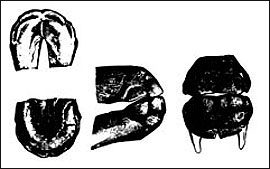
Canine teeth or "tusks" may appear midway between the incisors and molars at 4 or 5 years of age in the case of geldings or stallions, but seldom appear in mares. Adult horses have 24 molar teeth.
There are four major ways to estimate age of horses by appearance of their teeth:
- Occurrence of permanent teeth
- Disappearance of cups
- Angle of incidence
- Shape of the surface of the teeth
Occurrence of permanent teeth
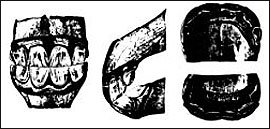
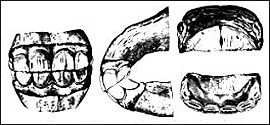
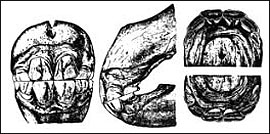
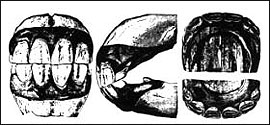
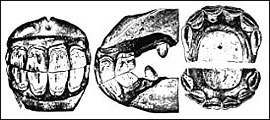
Horses have two sets of teeth, one temporary and one permanent. Temporary teeth may also be called "baby" or "milk teeth." Temporary incisors tend to erupt in pairs at 8 days, 8 weeks, and 8 months of age.
A well-grown 2-year-old may be mistaken for an older horse unless permanent teeth can be accurately identified. Permanent teeth are larger, longer, darker in color, and do not have the well-defined neck joining root and gum that temporary teeth do. Figure 4.
The four center permanent teeth appear (two above and two below) as the animal approaches 3 years of age, the intermediates at 4, and the corners at 5. This constitutes a "full mouth."
Disappearance of cups

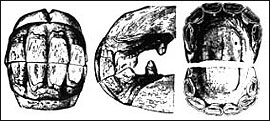
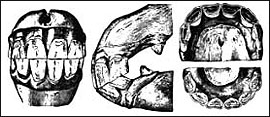
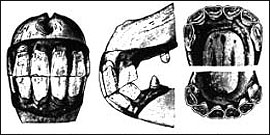
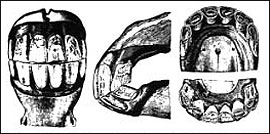



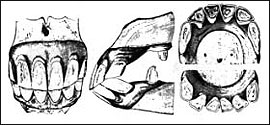
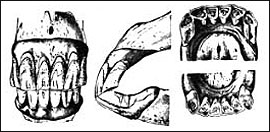
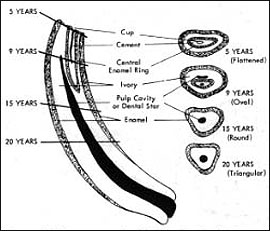
Young permanent teeth have deep indentures in the center of their surfaces, referred to as cups. Cups are commonly used as reference points in age determination. Those in the upper teeth are deeper than the ones below, hence they do not wear evenly with the surface or become "smooth" at equal periods of time. In general, the cups become smooth in the lower centers, intermediates, corners, upper centers, intermediates, and corners at 6, 7, 8, 9, 10, and 11 years of age, respectively. Figures 7 to 12. A "smooth mouth" theoretically appears at 11. A few horse owners ignore cups in the upper teeth and consider a 9-year-old horse smooth-mouthed. Although complete accuracy cannot be ensured from studying cups, this method is second in accuracy only to the appearance of permanent teeth in determining age.
As cups disappear, dental stars appear — first as narrow, yellow lines in front of the central enamel ring, then as dark circles near the center of the tooth in advanced age. Figure 17.
Angle of incidence
The angle formed by the meeting of the upper and lower incisor teeth (profile view) affords an indication of age. This angle of incidence or "contact" changes from approximately 160 to 180 degrees in young horses, to less than a right angle as the incisors appear to slant forward and outward with aging. Figures 5, 8, 11, 15, and 16. As the slant increases, the surfaces of the lower corner teeth do not wear clear to the back margin of the uppers so that a dovetail, notch, or hook is formed on the upper corners at 7 years of age. It may disappear in a year or two, reappear around 12 to 15 years, and disappear again thereafter. Figures 8, 10, 12, 14, and 15. The condition varies considerably between individuals, but most horses have a well-developed notch at 7.
Shape of the surface of the teeth
The teeth undergo substantial change in shape during wear and aging. Figure 17. The teeth appear broad and flat in young horses. They may be twice as wide (side to side) as they are deep (front to rear). This condition reverses itself in horses that reach or pass 20 years. From about 8 to 12 years the back (inside) surfaces become oval, then triangular at about 15 years. Twenty-year-old teeth may be twice as deep from front to rear as they are wide. Study these differences in Figures 3, 10, 15, and 16.
Abnormal teeth conditions
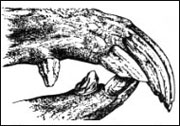
"Parrot mouth" is a result of the upper and lower incisors not meeting because the lower jaw is too short. This condition is rather common and may seriously interfere with grazing. Figure 18.
"Monkey mouth" is the opposite of parrot mouth and is seldom seen in horses.
"Cribbing" is a habit common to stabled horses which damages incisors by chipping or breaking them.
"Bishoping" is tampering with cups to make the horse appear younger than it is.
"Floating" is filing high spots in molars to facilitate chewing. Molars should be checked regularly by veterinarians as the horse approaches mid-life and should be kept floated as needed thereafter.
Definition
"Galvayne's Groove." A groove said to appear at the gum margin of the upper corner incisor at about 10 years of age extends halfway down the tooth at 15 years and reaches the table margin at 20 years. It then is said to recede and disappear at 30 years.